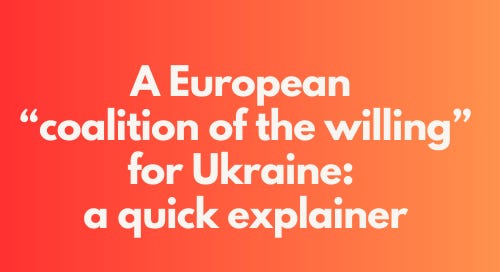A European "coalition of the willing" for Ukraine: a quick explainer
28 March 2025
The summit on Thursday, 27 March 2025, brought together heads of state and government from 31 European states in Paris, often referred to as a “coalition of the willing” to support Ukraine. The term sounds of course promising as it implicitly suggests the participating states’ willingness to take resolute action, but it is important to manage expectations towards this format for several reasons.
This quick explainer provides an overview what a European coalition of the willing for Ukraine could achieve and what could limit its success.
It’s too early to call it a coalition — more an intergovernmental gathering.
First, let’s start with a definition. Coalitions of the willing can generally be described as “willing and able actors, primarily states but in no way restricted to them, com[ing] together (coalesce) in order to pursue certain common objectives. The goals pursued are usually pressing global threats and challenges, and the endeavours to address them therefore of an urgent and case-specific nature, assigning coalitions of the willing an ad hoc character that distinguishes them from standing alliances” (Rodiles, 2018). Politically, the term is strongly associated with the US intervention of Iraq in 2003, where a group of countries supported the US intervention without a formal UN mandate.
Whether the group of countries which decide to step up support for Ukraine will actually morph into such a coalition remains to be seen. The meeting on Thursday was the first time for the group to come together in this format; as this meeting stands in continuity with previous emergency summits with ever-changing groups of states, it seems way too early to actually refer to the group of states that met on Thursday as a coalition of the willing. At the moment, it was a unique intergovernmental gathering, which might, at one point, morph into a coalition of the willing, especially if members meet more permanently and do not leave it at a single meeting.
Manage expectations on consensus in the group.
The countries that participated in the Thursday gathering all clearly expressed their willingness to support Ukraine, but this does not imply that they will easily agree on the instruments or the political message that should result from their cooperation.
Even though Hungary, which regularly blocks strong EU language on Ukraine, was not part of the meeting, the discussion on the potential deployment of European “boots on the ground” clearly demonstrates the frictions within the group. While French President Emmanuel Macron and British Prime Minister Keir Starmer emphasise the importance of a potential “reassurance force” consisting of European troops deployed to Ukraine after a ceasefire, Italian Prime Minister Georgia Meloni warned that this could be perceived as a threat, and that Europeans should rather consider extending NATO’s article 5 guarantee to Ukraine without actually granting the country membership in the alliance.
The most important aspect of the group is hence the political signal it is sending — namely the willingness to resolutely support Ukraine. This can take very different forms of commitment: while some states might be more willing to step up financial support, others might be willing to go as far as sending troops. However, the signalling here is important for participating states: either they participate at least in the meetings and demonstrate that they are willing to go further than it might be possible within only the EU or only through bilateral cooperation, or they do not participate in the meeting, like Hungary — and that is a statement in itself.
The group could be the format to agree on an actual “coalition of the willing” for military support.
While historically associated with military intervention, coalitions of the willing can be political or diplomatic in scope. In the case of the countries meeting to support Ukraine, the military dimension — namely the question whether Europeans should deploy troops to Ukraine — is clearly underpinning the discussions.
How could such a European deployment result from this ad hoc grouping of states? The most likely result is the formation of an actual military coalition of the willing, meaning that certain states decide to commit to a deployment of troops and jointly agree which state takes the military leadership. Other states might only endorse this idea politically and thereby support the actual coalition of the willing, but not deploy troops themselves.
Accordingly, meetings like the Thursday gathering can be helpful to explore synergies of states willing to go further and can thereby actually foster the creation of a European coalition of the willing. But for the time being, the Thursday meeting was not much more.



